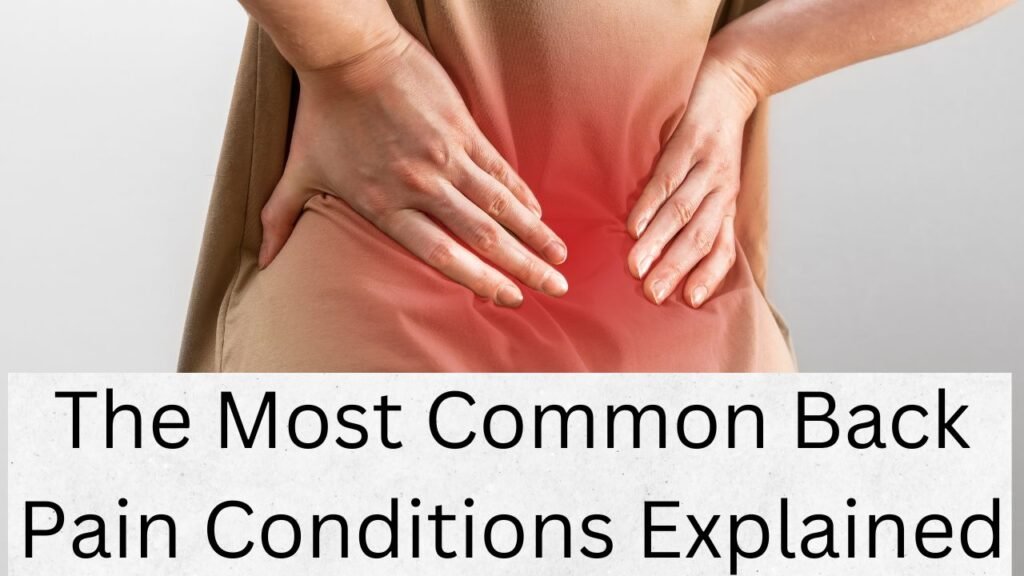Back pain is one of the most widespread health issues, affecting millions of people worldwide. It can range from mild discomfort to severe, debilitating pain. Understanding the most common back pain conditions is crucial for proper diagnosis and treatment. Here’s a breakdown of the primary causes of back pain and how to manage them effectively.

1. Herniated Disc
A herniated disc occurs when the soft inner material of a spinal disc pushes through its outer shell. This can press on nearby nerves, causing pain, numbness, or weakness, usually in the lower back or neck.
Symptoms:
- Sharp or burning pain in the lower back, buttocks, or legs (sciatica)
- Numbness or tingling in affected areas
- Muscle weakness, making it hard to lift or hold objects
Treatment:
- Rest and physical therapy
- Anti-inflammatory medications
- In severe cases, surgery may be necessary
2. Degenerative Disc Disease (DDD)
As we age, spinal discs lose their cushioning, leading to pain and stiffness. This condition can contribute to other spinal problems like herniated discs and osteoarthritis.
Symptoms:
- Chronic pain in the lower back or neck
- Pain that worsens when sitting for long periods
- Occasional numbness or tingling in the limbs
Treatment:
- Low-impact exercises to strengthen core muscles
- Pain management with NSAIDs or corticosteroid injections
- Lifestyle adjustments, such as weight management and improved posture
3. Spinal Stenosis
Spinal stenosis is the narrowing of the spinal canal, which can compress nerves and lead to discomfort. This condition is more common in older adults.
Symptoms:
- Pain or cramping in the lower back and legs
- Weakness or numbness in the extremities
- Symptoms worsen when standing or walking but improve when sitting
Treatment:
- Physical therapy to improve mobility
- Anti-inflammatory drugs or steroid injections
- Surgical intervention in severe cases
4. Sciatica
Sciatica occurs when the sciatic nerve, which runs from the lower back down each leg, becomes compressed or irritated, often due to a herniated disc or spinal stenosis.
Symptoms:
- Sharp, radiating pain from the lower back to the legs
- Numbness or tingling sensation
- Weakness in the affected leg
Treatment:
- Stretching and strengthening exercises
- Over-the-counter pain relievers
- Chiropractic care or epidural injections for severe cases
5. Osteoarthritis of the Spine
Osteoarthritis (OA) is the breakdown of cartilage in the joints, including those in the spine. It often leads to bone spurs, which can cause pain and reduced flexibility.
Symptoms:
- Stiffness and aching in the back, especially in the morning
- Pain that worsens with activity
- Limited range of motion
Treatment:
- Weight management and low-impact exercise
- Physical therapy and massage
- Pain relief medications like acetaminophen or NSAIDs
6. Scoliosis
Scoliosis is an abnormal curvature of the spine that often develops during adolescence. Severe cases can lead to chronic pain and mobility issues in adulthood.
Symptoms:
- Uneven shoulders or hips
- Back pain that worsens over time
- Difficulty standing for long periods
Treatment:
- Bracing for mild to moderate cases (especially in children)
- Physical therapy to strengthen core muscles
- Surgery for severe spinal curvature
7. Muscle Strain and Ligament Sprains
Overuse, improper lifting, or sudden movements can cause strains in back muscles and ligaments. This is one of the most common causes of acute back pain.
Symptoms:
- Sudden, sharp pain in the back
- Muscle spasms or stiffness
- Difficulty moving without discomfort
Treatment:
- Rest and ice therapy for initial relief
- Gradual return to movement with stretching and strengthening exercises
- Pain relievers and muscle relaxants if needed
8. Ankylosing Spondylitis
This is a form of inflammatory arthritis that primarily affects the spine, leading to pain, stiffness, and potential fusion of the vertebrae.
Symptoms:
- Chronic pain and stiffness, especially in the lower back and hips
- Symptoms worse in the morning or after periods of inactivity
- Reduced flexibility over time
Treatment:
- Anti-inflammatory medications (NSAIDs)
- Regular physical therapy and stretching
- Biologic medications for severe inflammation
9. Fibromyalgia
Fibromyalgia is a chronic condition that causes widespread pain, including in the back. It often coexists with fatigue, sleep disturbances, and cognitive issues.
Symptoms:
- Persistent dull pain throughout the body
- Tender points in the back, neck, and shoulders
- Difficulty sleeping and chronic fatigue
Treatment:
- Regular exercise and stress management
- Medications such as antidepressants and pain relievers
- Cognitive-behavioral therapy (CBT) for pain management
10. Kyphosis
Kyphosis is an exaggerated forward curvature of the upper back, often referred to as a hunchback. It can result from poor posture, osteoporosis, or congenital issues.
Symptoms:
- Visible rounding of the upper back
- Back pain and stiffness
- Fatigue due to poor posture
Treatment:
- Postural training and core-strengthening exercises
- Bracing for younger patients with progressive curvature
- Surgery for severe cases causing nerve compression
When to See a Doctor
While some back pain conditions can be managed with self-care, it’s important to seek medical attention if:
- Pain persists for more than a few weeks
- You experience numbness or weakness in the legs
- There is loss of bladder or bowel control
- The pain follows a fall or injury
Conclusion
Back pain can stem from various conditions, each requiring specific treatment approaches. Whether it’s a herniated disc, sciatica, or osteoarthritis, early diagnosis and proper management can help reduce pain and improve quality of life. If you’re experiencing chronic or severe back pain, consult a healthcare professional to determine the best course of action.